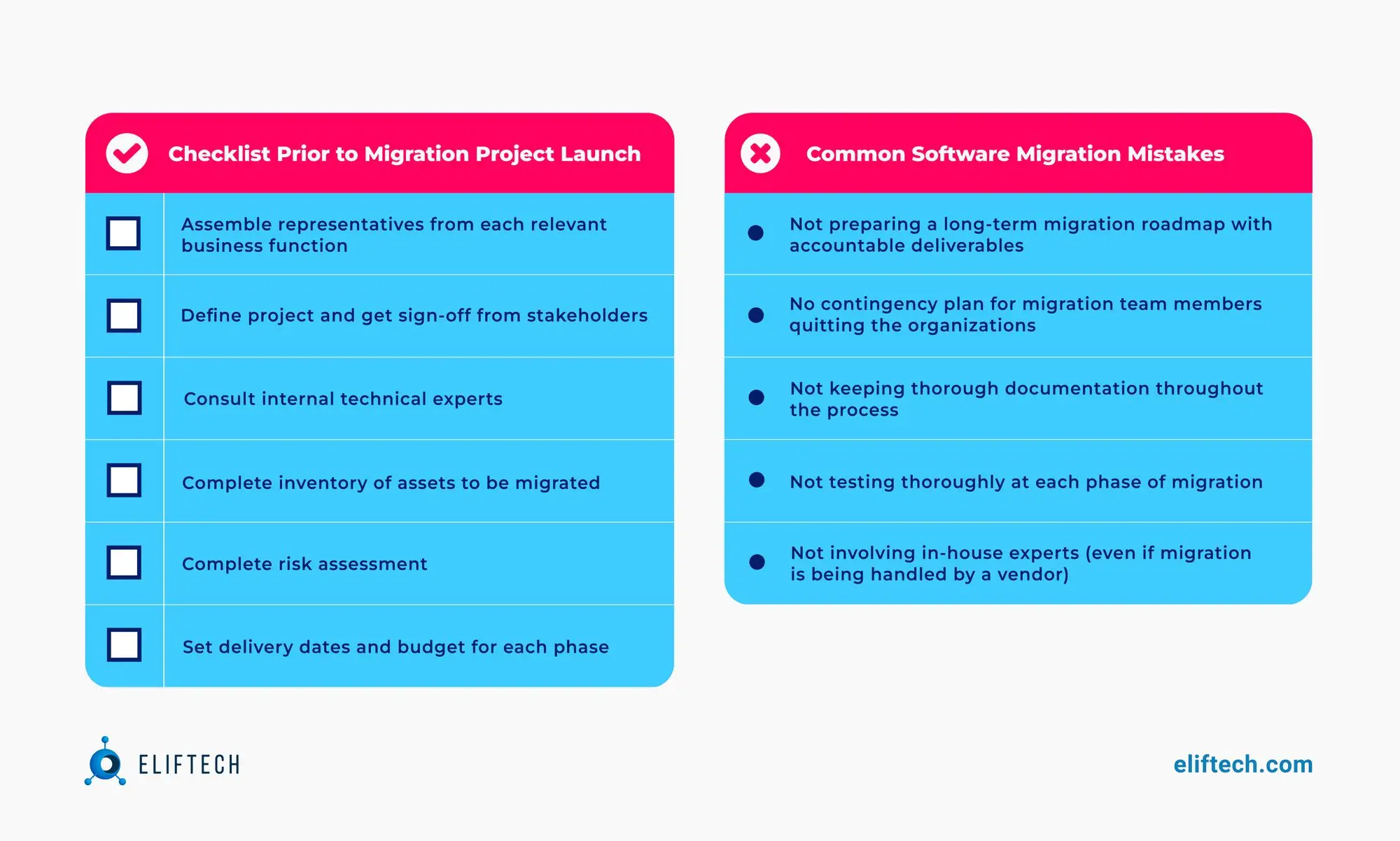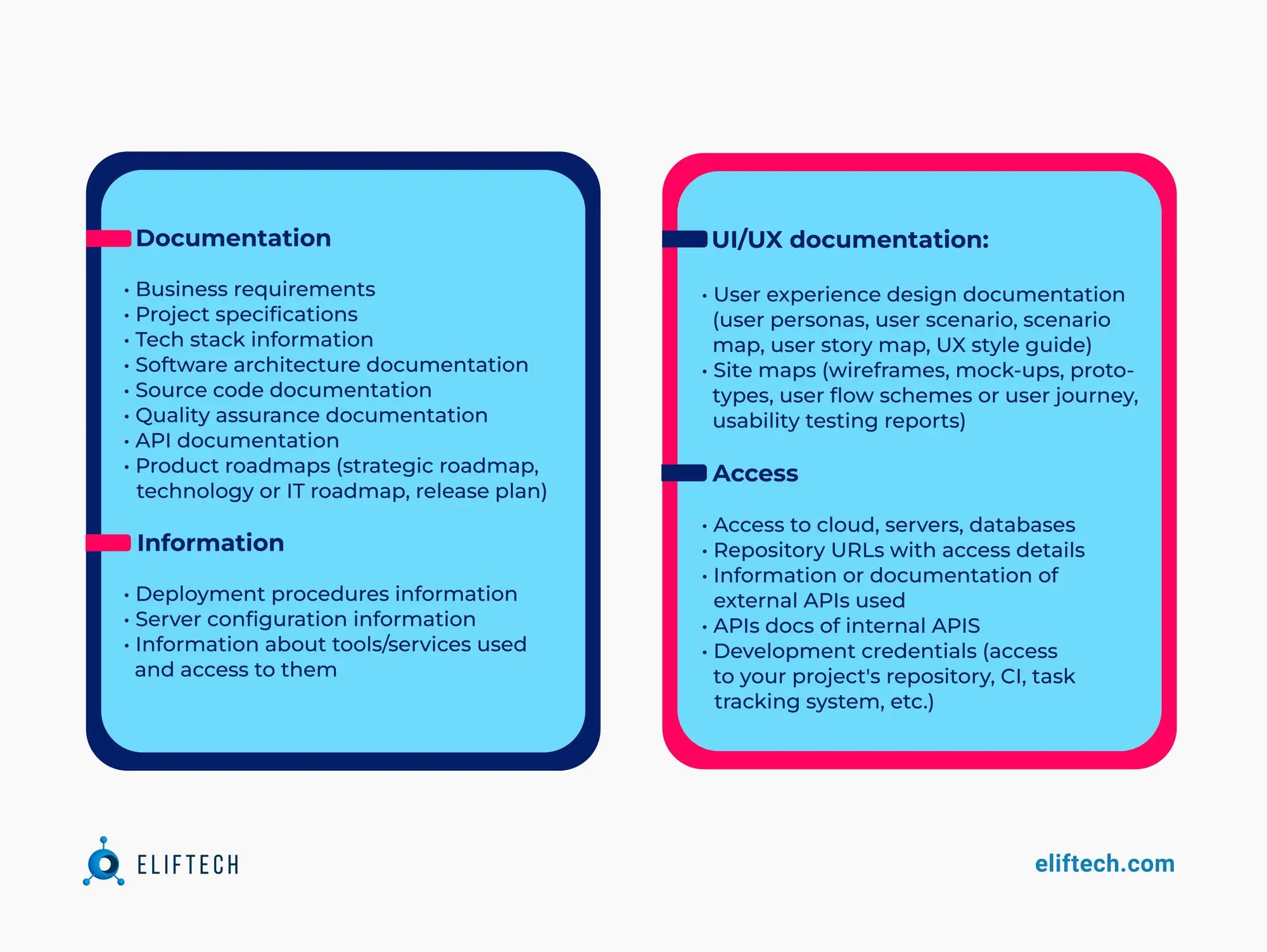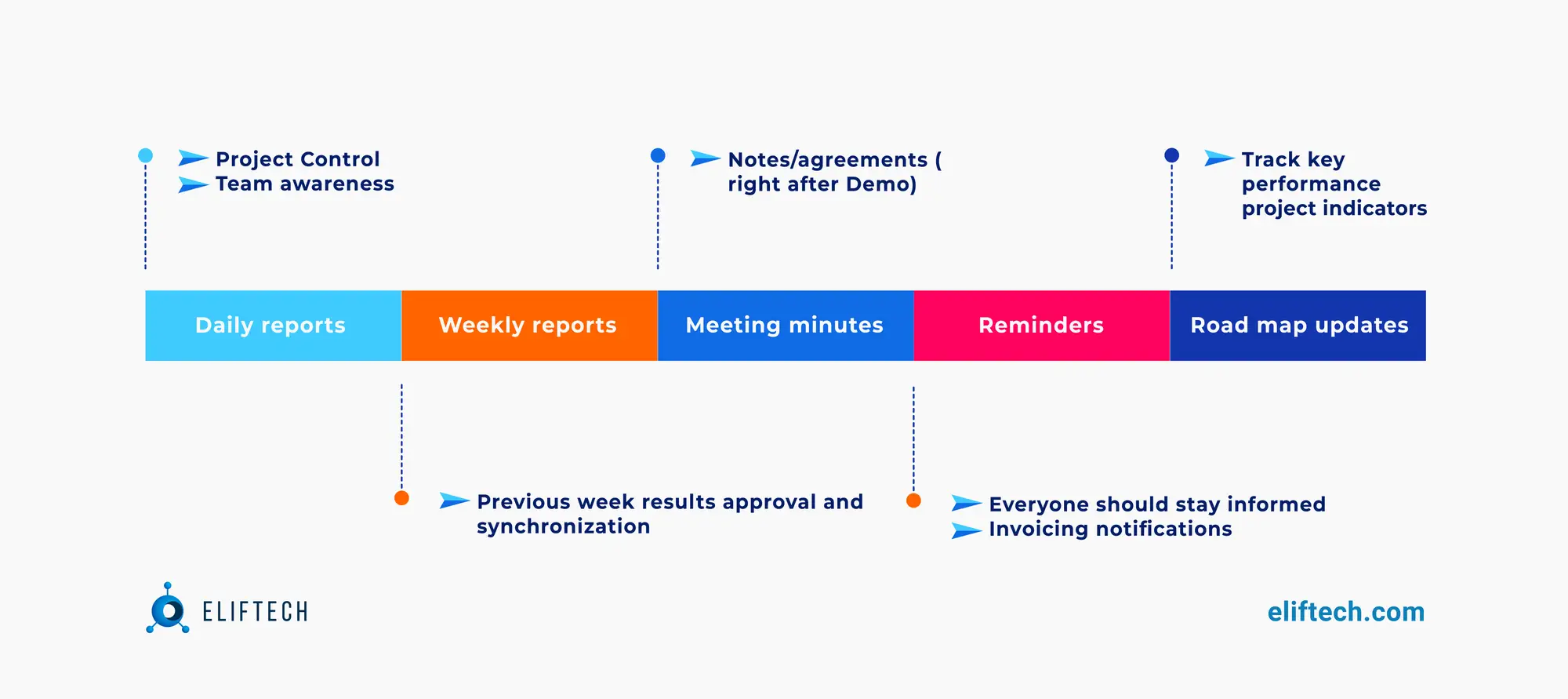Outsourcing
Look Before You Leap: A Guide to IT Project Transition Plan for a Smooth Vendor Switch

It's time to face the reality: your IT vendor is not delivering on its promises, and your project is not progressing as expected. They're slow, they keep missing deadlines, and the project team seems to be a revolving door of new faces every few weeks. You are receiving vague responses or no replies to your messages. Or you've reviewed the code, and it's subpar. If this sounds familiar, you might wonder how to switch IT vendors mid-project.
Switching IT vendors can make you feel overwhelmed. The project is already in progress, and you're worried about how to manage the transition. But as much as it seems like a daunting process, there are steps you can take to ensure a smooth and successful switchover. The best way to make a transition is to have a well-prepared IT project transition plan that can help you make the switch without any disruption to your business operations.
In this article, we will guide you through some tips and advice that can help you have a smooth transition with your next IT provider. Moreover, our ready-to-go IT project transition plan guide will help you take action immediately.
Ready for greater changes?
Why Do You Need an IT Project Transition Plan: 5 Reasons for Vendor Switch in the IT Industry
IT outsourcing is an effective way for IT organizations to reduce costs, eliminate low-value tasks, and focus on core competencies. When comparing in-house vs outsourcing, the second option usually wins for those needing scalability and access to specialized expertise. However, the outsourcing path can be challenging, with up to 25% of outsourcing relationships failing within two years. And while much attention is given to evaluating and selecting an outsourcing vendor, the transition process is often overlooked, which can lead to significant challenges, costs, and risks.
Vendor transitioning is a common practice for tech startups or businesses that are looking for better service or value. But what causes businesses to switch IT vendors mid-project?
Here are five reasons you should consider switching IT vendors:
- No dynamics or low efficiency: The pace of technological advancements in the IT industry is unparalleled. With new tools, software, and platforms emerging daily, businesses must ensure they're using the best and most up-to-date solutions. If a vendor fails to keep up with these advancements or doesn't offer the latest technology, businesses might consider switching to a different vendor that provides cutting-edge solutions to stay competitive.
- Unjustified delays and high downtime: In the IT industry, time is money. Businesses rely on vendors to provide fast and reliable services to ensure uninterrupted operations. If a vendor fails to deliver on promised deadlines or experiences high downtime without a valid reason, businesses may switch to a vendor that offers better service level agreements (SLAs) and faster response times. High downtime can cause significant financial losses and damage to a company's processes, making it a critical factor to consider when choosing a vendor.
- Insufficient communication and poor customer support: Excellent customer support is critical in the IT industry, as the complexity of technology can often lead to challenges and issues that require immediate attention. Businesses rely on vendors to provide timely and effective support to resolve these issues. If a vendor's customer support lacks quality, responsiveness, or expertise, businesses may switch to a vendor offering superior customer service to ensure uninterrupted operations.
- Lack of customization: As businesses in the IT industry continue to grow and evolve, their needs and requirements change. A vendor must be able to offer solutions that can be easily integrated with existing systems and customized to meet the company's unique needs. If a vendor is inflexible or unable to provide tailored solutions, businesses may switch to a vendor that offers greater integration and customization capabilities to support their strategic objectives.
- Lack of scaling: As businesses in the IT industry grow and expand their operations, they need vendors that can keep up with their increasing demands. If a vendor is unable to scale their services or doesn't have the necessary infrastructure to support the company's growth, businesses may switch to a vendor that offers more scalable solutions. That's why software maintenance and support services should be another criterion when choosing a vendor. A lack of scaling can result in decreased productivity, missed opportunities, and increased costs, making it essential for businesses to choose vendors that can accommodate their growing needs.
- Budget overruns: Cost reduction is always a top priority in any business. Companies in the IT industry are no exception, especially as they face increasing competition and tightening budgets. If a vendor isn't able to provide cost-effective solutions or if the pricing model doesn't align with the company's financial goals, businesses may switch vendors to reduce expenses and optimize their investments.
Switching vendors in the IT industry is a decision that should not be taken lightly, as it can significantly impact a company's operations, security, and bottom line. However, embracing change and finding the right vendor can lead to increased efficiency, cost savings, and a competitive edge. If your business is experiencing any of the abovementioned issues, it might be time to consider a vendor switch to support your company's growth and success better.
Potential Challenges
According to various sources, an IT project transition plan that successfully switches vendors can take anywhere from 2-3 months, and the complexity of the project plays a significant role in determining the length of the transition. Additionally, the current stage of the project’s development can also impact the transition duration.
Switching vendors in the IT industry can be a strategic move to improve business operations, but it's not without its challenges. The transition from one vendor to another requires careful planning and management to minimize disruptions and ensure a smooth process.
Here are three crucial factors to weigh when determining how to handle a project that isn't meeting your expectations:
- Contractual obligations with a current vendor: Businesses often have contractual obligations with their current vendors, which can make switching vendors more complex. Early termination fees, penalties, or other contractual constraints may make it difficult or costly to switch vendors. To address this challenge, businesses should review their current contracts, negotiate with their existing vendor if necessary, and ensure that they fully understand the terms of the new vendor's agreement to avoid unexpected costs or legal issues.
- Data migration and integration: One of the major challenges when switching vendors is the transfer of data and the integration of new systems. Businesses must ensure that their data is securely migrated and the new vendor's solutions are compatible with their existing systems. This process can be time-consuming and may require additional resources. To mitigate this challenge, companies should work closely with their new vendor to develop a detailed migration plan, conduct thorough testing, and allocate sufficient resources to the project.
- Service disruption: Switching vendors can sometimes lead to temporary service disruptions, which can impact business operations and customer satisfaction. Moreover, after announcing your plans to terminate cooperation, the vendor may reassign development resources to another project, or the developers themselves may lose motivation. To minimize the risk of service interruptions, businesses should work closely with the new vendor to develop a detailed transition plan, including contingency plans for potential issues. Additionally, companies should communicate proactively with their customers about the vendor switch and any potential service disruptions, ensuring they are well informed and their expectations are managed.
So by addressing potential challenges head-on and developing strategies to overcome them, companies can ensure a smooth transition and a stronger, more competitive position in the market.
A Guide for Planning Future Vendor Transitions
In the fast-paced world of the IT industry, businesses must constantly adapt and evolve to stay competitive. Vendor transitions are often a necessary part of this process as companies seek to improve their services, reduce costs, or scale their operations.
Here, we'll discuss the main steps in planning for future vendor transitions to minimize disruptions and ensure a successful transition.
Step 1: Evaluate the previous vendor
To avoid repeating the same mistakes as previous vendors, examine their performance first. By reviewing previous vendors' work and identifying what went wrong, you can develop a comprehensive plan that outlines what needs to be done differently in the future.
ElifTech has a reputation for thorough code reviews and debugging capabilities.
Step 2: Determine the project scope and requirements
Before starting a vendor transition, evaluate the project complexities and requirements to identify what needs to be improved, what needs to stay the same, and what issues must be addressed by the new vendor. This will help you define your expectations and identify potential vendors that meet your requirements.
At ElifTech, we help our clients determine the project scope and requirements as a part of our software consulting services.
Step 3: Establish clear goals and objectives
Before initiating a vendor transition, businesses should establish clear goals and objectives for the change. These might include cost savings, improved service quality, or enhanced scalability. By setting clear goals, businesses can better evaluate potential vendors and ensure that the chosen vendor aligns with their strategic objectives.
Step 4: Develop a comprehensive IT project transition plan
A detailed IT project transition plan is essential for a successful vendor switch. This plan should outline the steps, timelines, resources required for the transition, and any potential risks and contingencies. Involving key stakeholders, such as IT teams and department heads, in the planning process can help to identify potential challenges and ensure a smooth transition.
Step 5: Conduct thorough vendor evaluation and selection
Choosing the right vendor is crucial for a successful transition. Businesses should thoroughly evaluate potential vendors, considering factors such as their expertise, scalability, and compatibility with existing systems. This may involve researching vendors, seeking recommendations from industry peers, and conducting in-depth interviews or demonstrations.
Step 6: Review and negotiate vendor contracts
Before signing a contract with a new vendor, businesses should thoroughly review the terms and conditions, ensuring that they align with their goals and requirements. This may involve negotiating specific clauses or terms, such as service level agreements (SLAs), termination provisions, or data security requirements.
Step 7: Prepare for data migration and integration
Data migration and system integration are often among the most challenging aspects of a vendor transition. To minimize disruptions, businesses should develop a detailed data migration plan, allocate sufficient resources, and conduct thorough testing before the switch.
Step 8: Communicate and train employees
Effective communication and training are essential for ensuring a smooth vendor transition. Businesses should inform employees about the upcoming change, its benefits, and any potential impacts on their roles. Comprehensive training on the new systems and processes can help minimize disruptions and ensure a seamless transition.
Planning for future vendor transitions in the IT industry is critical for businesses looking to stay competitive and adapt to changing market conditions. Businesses can minimize disruptions and ensure a successful vendor switch by following these steps, such as establishing clear goals, developing a comprehensive transition plan, and maintaining effective communication with employees and vendors.
ElifTech Experience with Project Migrations
Project migration can be a complex and challenging process, but when done right, it can significantly improve efficiency, cost savings, and overall business performance. Here, we'll share ElifTech's experience with project migration and the best practices we've developed to ensure a smooth and successful transition.
Our team at ElifTech has worked with several clients over the years to migrate their projects from different vendors, and through our experience, we have developed a clearly defined migration process that can help you navigate your way through the transition to a new IT vendor. This process involves five key steps that we believe are crucial for a successful vendor switch.
Preparation
ElifTech's project migration journey begins with extensive planning and preparation. The project transition plan begins with understanding the current stage of development, identifying the main problems faced by the previous vendor, finding solutions, and preventing similar issues in the future.
Then we develop a detailed migration plan outlining the steps, timelines, and resources required for the transition. The preparation stage involves establishing processes, developing a schedule, identifying and outlining roles and responsibilities, evaluating project risks, devising corresponding mitigation strategies, and deciding on communication methods and channels.

Step 1: Documentation transfer
The first step in the process of switching to a new IT vendor is to ensure that all documentation related to your project is transferred to the new vendor. This includes project requirements, project plans, and any other important documentation related to the project. At ElifTech, we understand this step's importance and work closely with our clients to ensure that all documentation is transferred safely and securely.

Step 2: Project analysis
Once the documentation transfer is complete, the next step is to analyze the project to determine its current status and identify any potential risks. This involves reviewing the project timeline, budget, and other important metrics to ensure that the project is on track and has no significant roadblocks. Our team at ElifTech has extensive experience in project analysis, and we can help you identify any potential risks and develop a plan to mitigate them.
Step 3: Knowledge transfer
Knowledge transfer is essential to the migration process as it ensures that the new vendor understands the project and can effectively take over from the previous vendor. During this stage, the outgoing vendor or a client will share information such as project requirements, design specifications, code repositories, and any other relevant documentation with the incoming vendor. This is an important step as it enables the new vendor to get up to speed quickly and ensure that the project is not disrupted.
At ElifTech, we make sure that the knowledge transfer process is comprehensive, and we work closely with both an outgoing vendor and a client to ensure that all the necessary information is transferred. We also ensure that the knowledge transfer is conducted in a secure and controlled environment to protect the project's confidentiality.
Step 4: Communication and reporting
Effective communication and reporting are critical to the success of the migration process. During this stage, both a client and an incoming vendor need to establish clear communication channels to ensure that there are no gaps in the project's progress. This includes regular meetings, updates, and progress reports that keep everyone on the same page.
At ElifTech, we understand the importance of communication and reporting and ensure that all stakeholders are kept informed throughout the migration process. We use a range of communication channels, including messengers for real-time communication and video calls, to ensure that everyone is up to date with the project's progress. We also provide regular progress reports, including metrics such as project status, risks, and issues, to ensure everyone knows of potential problems.
Step 5: Transition completion
The final step in the migration process is transition completion. At this stage, the new vendor takes over the project completely, and the outgoing vendor's involvement comes to an end. This involves ensuring that all project deliverables have been transferred and any outstanding issues are resolved. The new vendor also needs to ensure that the project is running smoothly and that there are no disruptions.
At ElifTech, we make sure that the transition completion process is smooth and efficient. We work closely with both an outgoing vendor and a client to ensure that there are no outstanding issues and that we're fully equipped to take over the project. We also provide support during the early stages of the transition to ensure that any teething problems are resolved quickly.

Knowledge Transfer
At ElifTech, we have extensive experience in transferring software projects from clients' previous vendors, and we have found that a strategic and systematic approach to knowledge transfer is more likely to result in a successful transition.
When creating a knowledge transition plan for software projects, it's important to consider the following sources of information:
- Project specifications: Provide all available requirements, regardless of the development stage of your software project. Initial project documentation can also be helpful in providing background information for the new team.
- Code documentation: Well-documented source code can speed up the transition process and help the new team familiarize themselves with your project.
- Assets transfer: Your current team should hand over all project-related documents and files to the new team, including mockups, design files, and other assets. Consult with the newly hired team about their requirements to avoid any misunderstandings.
- Development credentials: The new team needs access to your project's repository, CI, task tracking system, and other tools to get started. Create new accounts if necessary and deactivate old ones.
- Deployment procedures: Make sure the new team is aware of your project's deployment process to avoid any issues.
- Other technical information: Include any other relevant technical information in the onboarding documents for the new team.
By considering these sources of information, you can ensure a successful knowledge transition plan for your software project.
Communication Strategy
A successful IT vendor transition relies on effective communication. Otherwise, it can lead to misunderstandings, delays, and even project failures. That's why establishing a proper communication strategy is a huge part of your knowledge transfer plan.
At ElifTech, we know that effective communication can help to make sure that everyone involved in the process gets what they need from it and make a transition as smooth as possible for a client. That's why we have our common communication approach, procedures, and action items:
- Communication plan with a client: This plan ensures that our clients are kept aware of what’s happening with their project and can provide feedback along the way.
- Real-time communication: Slack or other messengers for real-time collaboration within the development team and regular updates on progress, issues, and changes to the project.
- Regular Google meetings: Kick-off, weekly status, retrospective, and ad-hoc meetings.
- Project plan with clear objectives and expectations, including timelines, milestones, and roadmap.
- Feedback meetings with the PM.
By developing an effective communication plan, we can ensure that everyone involved in the transition is informed, engaged, and working towards the same goal.

The Bottom Line
Although it’s normal to worry about transitioning from one vendor to another, the transfer can be extremely smooth as long as you know the right steps to take. At ElifTech, we have a clearly defined migration process that ensures a seamless transition. Our experience has shown that project analysis, knowledge transfer, and communication and reporting are critical to the success of the migration process. And by following these key steps, we can help you switch to a new IT vendor with ease and minimal disruption to your project.
ElifTech can help you make the transition as smooth as possible. Contact us for any other questions here.
